
Sulmona is a comune (municipality) in the province of L'Aquila, in the Italian region of Abruzzo. It is located in the Valle Peligna, a plain once occupied by a lake that disappeared in prehistoric times. In the ancient era, it was one of the most important cities of the Paeligni and is known for being the native town of the Roman poet Ovid, of whom there is a bronze statue, located on the town's main road and named after him.

The Loggia dei Lanzi, also called the Loggia della Signoria, is a building on a corner of the Piazza della Signoria in Florence, Italy, adjoining the Uffizi Gallery. It consists of wide arches open to the street. The arches rest on clustered pilasters with Corinthian capitals. The wide arches appealed so much to the Florentines that Michelangelo proposed that they should be continued all around the Piazza della Signoria.
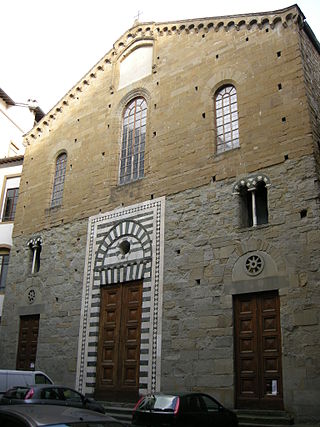
Santo Stefano al Ponte is a Romanesque-style, Roman Catholic church, located in the Piazza of the same name, just off the Via Por Santa Maria, near the Ponte Vecchio, in Florence, region of Tuscany, Italy. The church is presently used as a concert hall.
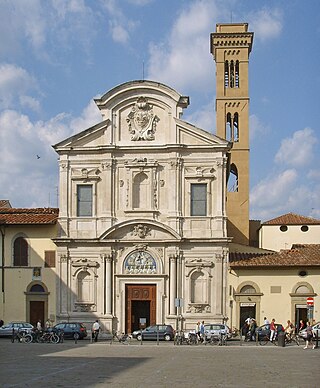
The chiesa di San Salvatore di Ognissanti, or more simply chiesa di Ognissanti, is a Franciscan church located on the piazza of the same name in central Florence, region of Tuscany, Italy. Founded by the lay order of the Umiliati, the church was dedicated to all the saints and martyrs, known and unknown.

Santa Trinita is a Roman Catholic church located in front of the piazza of the same name, traversed by Via de' Tornabuoni, in central Florence, Tuscany, Italy. It is the mother church of the Vallumbrosan Order of Monks, founded in 1092 by a Florentine nobleman. South on Via de' Tornabuoni is the Ponte Santa Trinita over the river Arno; across the street is the Palazzo Spini Feroni.
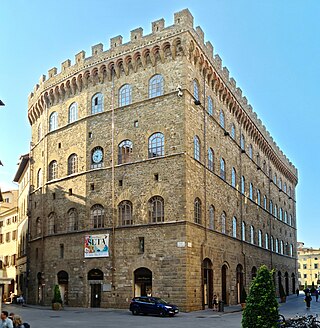
Palazzo Spini Ferroni is a large Gothic palace located along Via de' Tornabuoni at the corner of Piazza Santa Trinita, in central Florence, Tuscany, Italy. It stands across from the church of Santa Trinita.

Piazza della Repubblica is a city square in Florence, Italy. It was originally the site of the city's forum; then of its old ghetto, which was swept away during the improvement works, or Risanamento, initiated during the brief period when Florence was the capital of a reunited Italy—work that also created the city's avenues and boulevards. At that time, the Loggia del Pesce from the Mercato Vecchio was also moved to Piazza Ciompi. The square's Giubbe Rosse cafe has long been a meeting place for famous artists and writers, notably those of Futurism.

San Gaetano, also known as Santi Michele e Gaetano, is a Baroque church in Florence, Italy, located on the Piazza Antinori, entrusted to the Institute of Christ the King Sovereign Priest.

The Torre del Gallo is a historical building located in Florence, Italy, located at Pian de' Giullari, in the hills of Arcetri, on top of a ridge overlooking the city where there is a magnificent panorama.

Piazza del Duomo is located in the heart of the historic center of Florence. It is one of the most visited places in Europe and the world and in Florence, the most visited area of the city. The square contains Florence Cathedral with the Cupola del Brunelleschi, the Giotto's Campanile, the Florence Baptistery, the Loggia del Bigallo, the Opera del Duomo Museum, and the Arcivescovile and Canonici's palace. The west zone of this square is called Piazza San Giovanni.

The Mercato Centrale in Florence is located between via dell'Ariento, via Sant'Antonino, via Panicale and Piazza del Mercato Centrale. It is one of the results from the time of risanamento, the period when Florence was the capital of Italy in the late nineteenth century. It was designed by Giuseppe Mengoni, an architect who also conceived the Galleria Vittorio Emanuele II in Milan.
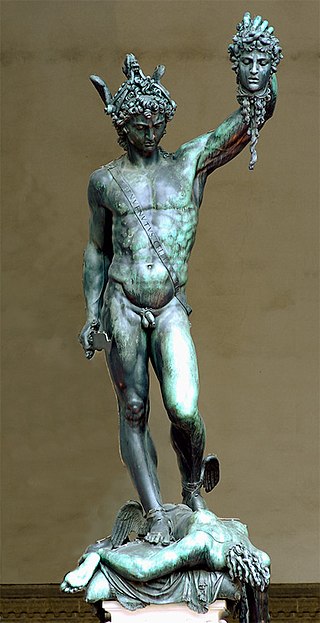
Perseus with the Head of Medusa is a bronze sculpture made by Benvenuto Cellini in the period 1545–1554. The sculpture stands on a square base which has bronze relief panels depicting the story of Perseus and Andromeda, similar to a predella on an altarpiece. It is located in the Loggia dei Lanzi in the Piazza della Signoria in Florence, Italy. The second Florentine duke, Cosimo I de' Medici, commissioned the work with specific political connections to the other sculptural works in the piazza. When the piece was revealed to the public on 27 April 1554, Michelangelo's David, Bandinelli's Hercules and Cacus, and Donatello's Judith and Holofernes were already installed in the piazza.

Piazza Santa Croce is one of the main plazas or squares located in the central neighbourhood of Florence, in the region of Tuscany, Italy. It is located near Piazza della Signoria and the National Central Library, and takes its name from the Basilica of Santa Croce that overlooks the square.

The Roman Theatre of Florence was a Roman theatre dated to the 1st century in Florentia, Italy. It was located under the current Palazzo Vecchio and Palazzo Gondi, with the auditorium facing Piazza della Signoria and along the Piazza San Firenze and Via dei Leoni.
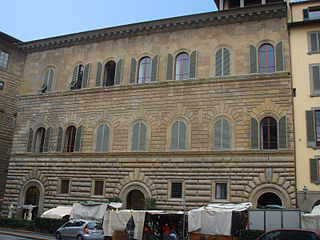
Palazzo Gondi is a palace in Florence, Italy, located a block from Piazza della Signoria. It was built in 1490 under design by Giuliano da Sangallo, who was inspired by other major works of stately buildings in the city, such as Palazzo Medici and Palazzo Strozzi. Among the elements borrowed from these earlier works are the cube-shape set around a central courtyard, the ashlar sloping on each of three floors, and the arched windows.
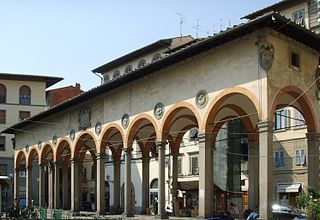
The Loggia del Pesce is a historical building in Florence, Italy. It is formed by nine wide arcades, supported by piers or columns. On each side are eight medallions depicting fishing activities and the sea. At the corners are four coats of arms.

Santi Simone e Giuda is a church in Florence, situated on the Piazza San Simone in an area of narrow streets between the Piazza Santa Croce and the Piazza della Signoria. The present structure dates from 1243 but underwent a major renovation designed by Gherardo Silvani in 1630. Today it is affiliated with the Ukrainian Greek Catholic Church.

The Torre degli Amidei is a tower in Florence, Italy. Dating from the upper Middle Ages, it is located near the Piazza della Signoria. Once located near the city's ancient walls, it belonged to the Amidei family, and, according to the tradition, was the alleged location of the killing of Buondelmonte de' Buondelmonti by one Amidei.

Hotel Helvetia & Bristol is a five-star boutique hotel in Florence, Italy. It is managed by Starhotels Group and is a member of the Leading Hotels of the World.
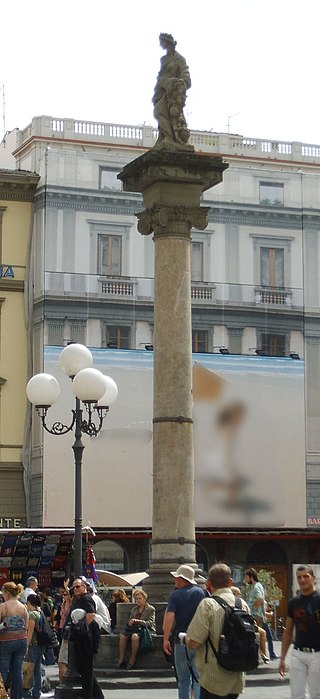
The Colonna dell'Abbondanza is a monumental column located in the Piazza della Repubblica in Florence, region of Tuscany, Italy.




















